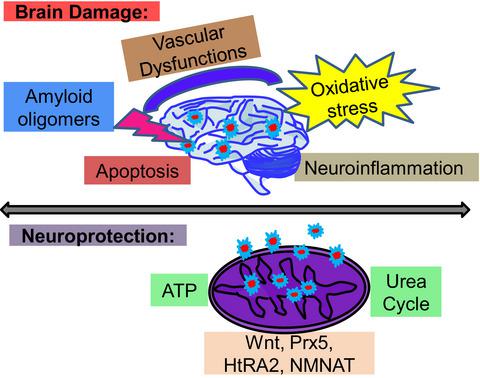Our official English website, www.x-mol.net, welcomes your
feedback! (Note: you will need to create a separate account there.)
Amyloid protein aggregates: new clients for mitochondrial energy production in the brain?
The FEBS Journal ( IF 5.5 ) Pub Date : 2020-01-25 , DOI: 10.1111/febs.15225 Senthilkumar Sivanesan 1 , Edwin Chang 2 , Mathew D Howell 3 , Jayakumar Rajadas 1, 4
The FEBS Journal ( IF 5.5 ) Pub Date : 2020-01-25 , DOI: 10.1111/febs.15225 Senthilkumar Sivanesan 1 , Edwin Chang 2 , Mathew D Howell 3 , Jayakumar Rajadas 1, 4
Affiliation

|
Mitochondria are key organelles, which maintain energy metabolism and cellular homeostasis. Mitochondria support transcriptional regulation and proteostatic signaling mechanisms through crosstalk between the mitochondria itself, the nucleus, and the cytoplasm. Mitochondrial dysfunction leads to impaired proteostasis, and both are key pathological features of age‐related neurological disorders. For example, Alzheimer’s and Parkinson’s diseases feature mitochondrial‐targeted protein aggregates and impaired mitochondrial function, although the mechanistic causes are poorly understood. Vascular abnormalities and hypometabolism in such neurological diseases are reported several years before key clinical disease symptoms even become apparent. Recent investigations suggest that processing of such aggregates within mitochondria can offer protective functions, specifically by restoring energy (ATP) in starving cells. We hypothesize that the accumulation of protein aggregates in mitochondria can not only disrupt its functions, but also render a protective role to fulfill energy demands in hypometabolic conditions. Growing evidence favors mitochondrial defense to toxic amyloid aggregates/oligomers as a protective response. In this viewpoint article, we will present several publications (in addition to our own) that serve to connect the possible role of protein aggregates in mitochondrial energy production for degenerative conditions.
中文翻译:

淀粉样蛋白聚集体:大脑中产生线粒体能量的新客户?
线粒体是关键的细胞器,可维持能量代谢和细胞稳态。线粒体通过线粒体本身,细胞核和细胞质之间的串扰来支持转录调控和蛋白抑制信号转导机制。线粒体功能障碍导致蛋白稳态受损,两者都是与年龄有关的神经系统疾病的关键病理特征。例如,尽管机制的原因尚不清楚,但阿尔茨海默氏病和帕金森氏病的特征是线粒体靶向的蛋白聚集体和线粒体功能受损。在关键的临床疾病症状甚至变得明显之前的几年中,已经报道了这种神经系统疾病中的血管异常和代谢不足。最近的研究表明,线粒体中此类聚集体的加工可提供保护功能,特别是通过恢复饥饿细胞中的能量(ATP)。我们假设线粒体中蛋白质聚集体的积累不仅会破坏其功能,而且在代谢不足的情况下满足能量需求具有保护作用。越来越多的证据表明线粒体对有毒的淀粉样蛋白聚集体/低聚物的防御是一种保护性反应。在这篇观点文章中,我们将介绍一些出版物(除了我们自己的出版物之外),这些出版物用于联系蛋白质聚集体在变性条件下在线粒体能量生产中的可能作用。我们假设线粒体中蛋白质聚集体的积累不仅会破坏其功能,而且在代谢不足的情况下满足能量需求具有保护作用。越来越多的证据表明线粒体对有毒的淀粉样蛋白聚集体/低聚物的防御是一种保护性反应。在这篇观点文章中,我们将介绍一些出版物(除了我们自己的出版物之外),这些出版物用于联系蛋白质聚集体在变性条件下在线粒体能量生产中的可能作用。我们假设线粒体中蛋白质聚集体的积累不仅会破坏其功能,而且在代谢不足的情况下满足能量需求具有保护作用。越来越多的证据表明线粒体对有毒的淀粉样蛋白聚集体/低聚物的防御是一种保护性反应。在这篇观点文章中,我们将介绍一些出版物(除了我们自己的出版物之外),这些出版物用于联系蛋白质聚集体在变性条件下在线粒体能量生产中的可能作用。
更新日期:2020-01-25
中文翻译:

淀粉样蛋白聚集体:大脑中产生线粒体能量的新客户?
线粒体是关键的细胞器,可维持能量代谢和细胞稳态。线粒体通过线粒体本身,细胞核和细胞质之间的串扰来支持转录调控和蛋白抑制信号转导机制。线粒体功能障碍导致蛋白稳态受损,两者都是与年龄有关的神经系统疾病的关键病理特征。例如,尽管机制的原因尚不清楚,但阿尔茨海默氏病和帕金森氏病的特征是线粒体靶向的蛋白聚集体和线粒体功能受损。在关键的临床疾病症状甚至变得明显之前的几年中,已经报道了这种神经系统疾病中的血管异常和代谢不足。最近的研究表明,线粒体中此类聚集体的加工可提供保护功能,特别是通过恢复饥饿细胞中的能量(ATP)。我们假设线粒体中蛋白质聚集体的积累不仅会破坏其功能,而且在代谢不足的情况下满足能量需求具有保护作用。越来越多的证据表明线粒体对有毒的淀粉样蛋白聚集体/低聚物的防御是一种保护性反应。在这篇观点文章中,我们将介绍一些出版物(除了我们自己的出版物之外),这些出版物用于联系蛋白质聚集体在变性条件下在线粒体能量生产中的可能作用。我们假设线粒体中蛋白质聚集体的积累不仅会破坏其功能,而且在代谢不足的情况下满足能量需求具有保护作用。越来越多的证据表明线粒体对有毒的淀粉样蛋白聚集体/低聚物的防御是一种保护性反应。在这篇观点文章中,我们将介绍一些出版物(除了我们自己的出版物之外),这些出版物用于联系蛋白质聚集体在变性条件下在线粒体能量生产中的可能作用。我们假设线粒体中蛋白质聚集体的积累不仅会破坏其功能,而且在代谢不足的情况下满足能量需求具有保护作用。越来越多的证据表明线粒体对有毒的淀粉样蛋白聚集体/低聚物的防御是一种保护性反应。在这篇观点文章中,我们将介绍一些出版物(除了我们自己的出版物之外),这些出版物用于联系蛋白质聚集体在变性条件下在线粒体能量生产中的可能作用。











































 京公网安备 11010802027423号
京公网安备 11010802027423号